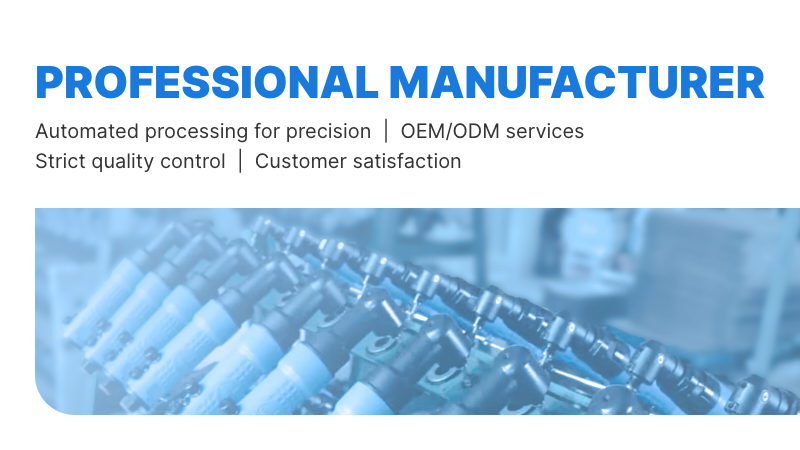Q&A
Air Tools / Pneumatic Tools use the compressed air supplied by the air compressor to drive the air motor to work. It can be used in the harsh environment of flammable, explosive, dusty, damp and shock. It is widely used in modern machinery manufacturing, ship building, automobile, airplane and so on. It does not pollute the environment, has long working life, simple structure and easy maintenance. Manufacturing, automotive repair, construction and decoration, metal / wood / stone processing, cutting, grinding, polishing, spraying, assembly, fastening and many other areas, is the modern mass production of large quantities of indispensable of the important tooling equipment.
Rotation type : Air Screwdriver 、Air Wrench 、Air Drill 、Air Sander 、Air Die Grinder.....etc.
Non-Rotation type : Air Nailer 、Air C-Ring 、Air Nipper 、 Air Shear....etc.
Reciprocating type : Air saw 、Air hammer 、Air needle scaler 、Air engraving pen ....etc
Pull type : Air rivet nut tool (Hydraulic)、Air revit ....etc.
Other : Air blow gun 、Air Caulking gun ...etc.
1. Air Leakage
Possible Causes: Damaged air hose、Aged connections、Worn or damaged seals
2. Reduced Performance or Insufficient Power
Possible Causes:
Low air pressure
Blocked air lines
Worn parts
Insufficient lubrication
Obstructions
3. Screws or Bolts Not Tightening Properly
Possible Causes:
Incorrect tool selection
Low air pressure
4. Tool Self-Rotation or Abnormal Operation
Possible Causes:
Trigger switch jammed by debris
Aged or damaged seals
5. Worn Parts
Common Wear Items Include:
Gears, washers, blades, bearings, O-rings, shims, retaining rings, chucks, springs, etc.
6. Improper Maintenance
Possible Causes:
Using different lubricants for the motor and impact mechanism. Using incorrect oil may cause jamming or damage.
Follow the operation manual and use the correct lubricants.
7. Maintenance Recommendations
If the tool produces abnormal noise, air leakage, or insufficient power, check air pressure, fittings, air lines, and lubrication first.
For issues that cannot be resolved, seek professional repair services.
Avoid disassembling the tool yourself to prevent secondary damage or safety hazards.
1. Air tools in terms of working capacity and power tools compared to small and lightweight.
2. Air tools are more suitable for long hours of work, and there is no motor overheating can not work like.
3. Even if the pneumatic tool of the aerodynamic motor overload occurs like a phenomenon, but the lifting of the load can be restored to normal operation, unlike the electric motor will burn problems.
4. Pneumatic tools are not used for electricity, only with the pressure source, the water resistance is strong, no electric shock hazard, and because of no electricity, the tool itself does not produce sparks, can be applied to explosive environments (such as Kouang, ). In the case of environmental applicability, it is more suitable for all kinds of adverse environments than other tools, but maintenance work (such as water treatment, dust removal, refueling, etc.) must be done.
5. Air tools follow-up maintenance costs lower than the power tools.
6. Compared with the power tools, air tools, early investment is more than power tools (air compressors and air lines, etc.).
| Length | ||||||
| 1 m | = | 1000 mm | = | 39.4 in | = | 3.28 ft |
| 1 in | = | 25.4 mm | = | 0.0254 m | = | 0.0083 ft |
| 1 ft | = | 12 in | = | 0.3048 m | = | 304.8 mm |
| Weight | ||||||
| 1 kg | = | 1000 g | = | 2.20462 lb | ||
| 1 lb | = | 0.453592 kg | ||||
| Torque | ||||||
| 1 Nm | = | 0.7375562 ft-lb | = | 0.101972 kgfm | = | 8.85 in-lb |
| 1 kgfm | = | 9.80665 Nm | = | 7.233 ft-lb | = | 86.81 in-lb |
| 1 ft-lb | = | 1.35582 Nm | = | 0.138 kgfm | = | 12 in-lb |
| 1 in-lb | = | 0.113 Nm | = | 0.083 ft-lb | = | 0.0115 kgfm |
| Force | ||||||
| 1 N | = | 0.102 kg | = | 0.225 lbs | ||
| 1 kg | = | 9.807 N | = | 2.205 lbs | ||
| 1 lbs | = | 4.448 N | = | 0.454 kg | ||
| Pressure | ||||||
| 1 bar | = | 100 kPa | = | 0.1 MPa | = | 1.0197 kgf/cm2 |
| 1 MPa | = | 10.2 kgf/cm2 | = | 10 bar | ||
| 1 kPa | = | 0.01 bar | = | 0.010197 kgf/cm2 | = | 0.145038 psi |
| 1 psi | = | 6.89476 kPa | ||||
| 1 kg/cm2 | = | 98.0665 kPa | ||||
| Power | ||||||
| 1 kw | = | 101.972 kpm/cm2 | = | 0.238846 kcal/s | = | 859.845 kcal/h |
| = | 1.35962 hk | = | 1.34102 hp | = | 1000 w | |
| 1 kpm/s | = | 9.80665 w | ||||
| 1 hp | = | 745.7 w | ||||
| 1 hk | = | 735.499 w | ||||
| Flow Rate | ||||||
| 1 m3/min | = | 16.6667 L/s | = | 35.335 cfm | ||
| 1 cfm | = | 0.471947 L/s | = | 0.0283 m3/min | = | 28.316846 l/min |
| 1 l/min | = | 0.035314 cfm | ||||
| 1 L/s | = | 2.1189 cfm | ||||
| 1 m3/h | = | 0.27778 L/s | = | 16.6667 l/min | ||



